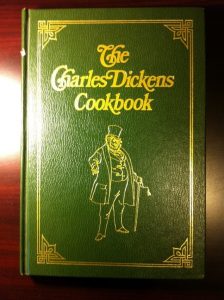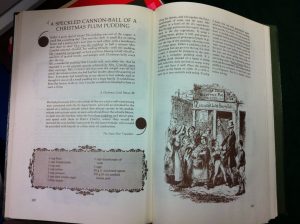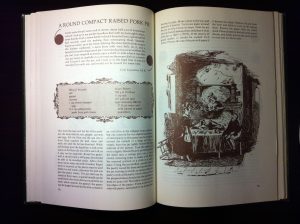Using the Whole Animal: Domestic Economy in The Charles Dickens Cookbook
This post has been contributed by Christian Dickinson.
In 1980, Brenda Marshall brought out The Charles Dickens Cookbook, a text which features a brilliantly eclectic mix of dishes and recipes from the mid-Victorian Era, based on the writings of the Inimitable himself. In the Author’s Note from the front page, Marshall describes the intended audience for this unique work: “The recipes in this book are intended for those who take pleasure both in food and in the writings of Charles Dickens” (4). Marshall adds that “Nearly all the dishes described here, although they belonged to the nineteenth-century table, can be cooked and enjoyed today, although some of the recipes have been given for their idiosyncratic and informative value alone” (4). The Charles Dickens Cookbook is one of the most unique cultural artifacts in all Victorian scholarship due to the manner in which the text is compiled, as well as what the recipes themselves tell us about both Dickens and nineteenth-century domestic economy as a whole.
One of the most enjoyable characteristics of this text is the way in which it is compiled. The recipes themselves are beautifully arranged, weaving together image and text in a way that is aesthetically pleasing without being gaudy. After the title of the dish, all recipes begin with a quotation from the Dickens work in which the particular food is mentioned, followed by its attribution. Many times, Marshall will then give a brief description of the dish, its place in the Victorian diet and domestic economy as well as any differences in preparation from that era to today. For example, before the recipe for ‘Melted Butter Celery Sauce’ Marshall tells us that “Melted Butter Sauce was the basic constituent of most English Sauces, and, according to Tallyrand, it was the only one the English knew” (66). Before the recipe for a basic ‘Cooling Jelly’, Marshall reminds us that in the nineteenth-century, “Making jelly … was not a simple matter of opening a pre-prepared packet; it involved the laborious task of making a good, clear jellied stock from calf’s feet” (132). The recipes themselves are then off-set within an elegant Victorian framework, followed by instructions for preparation. For certain recipes, the instructions for preparation can become quite complex, originating as they do in an era before pre-made crusts, instant dough mixtures or refrigeration. One recipe which shows this difference is the one for ‘Christmas Plum Pudding’:
A clothed pudding must be immersed in steadily boiling water, having it resting on a plate or rack in the bottom of the saucepan to prevent it burning … Do not allow the water to go off the boil, and when adding extra water to replace that which has evaporated, always use boiling water. Boil for 8 hours. Allow to cool and dry completely, then hang clothed pudding in a cool place … Boil for a further two hours before serving. (12)
With extensive guidelines for preparation such as these, we as readers are able to sympathize much more readily with the anxieties of a character like Mrs. Cratchit, who would have had to stand over a copper of boiling water for eight hours, replacing the water which evaporates, making sure that the cloth does not come undone or that the pudding does not adhere to the sides of the pot—any one of which possibilities could prove disastrous, particularly for the family who does not have much else for Christmas dinner.
Thinking about Mrs. Cratchit helps readers to consider what is perhaps the most important cultural aspect of The Charles Dickens Cookbook—that of domestic economy, or, the weekly household-budget for the average Victorian family. In the Cookbook, domestic economy can be seen in the layout of the book itself, as well as in its connections to the works of Dickens and the culture of the poor and working-class peoples of the era.
In the placement of quotation, recipe, description, instructions for preparation and image, not a space is wasted. The text for both recipe and quotation are the same size and font, but easily distinguished through the use of large quotation marks and the frame that off-sets each recipe. This allows space to be given for long quotations, making the book a literary artifact more than simply a listing of recipes.
There is also something quite interesting to note in the frequency with which certain texts recur. To Marshall’s great credit, almost all of Dickens’s major novels are represented, in addition to a handful of meals from the Christmas books and early sketches. Even more impressive is the fact that the major works are given mostly equal play, with the primary novels being given around ten recipes each. However, when considering the content of the works themselves, the novels that have the most and the fewest number of recipes associated with them make complete analytical sense. For Dickens, food is many times associated with celebration, in particular those moments of celebration in his novels connected to scenes of the large, happy Victorian family. It is no surprise then, that David Copperfield, the novel which concerns the creation and reunion of families, features twenty recipes, twice as many as the average. It is also no surprise that the one novel which does not feature at all in the book is Hard Times, that narrative of broken family and the enforced solitude that accompanies the horrors of industrialization. For Dickens, food is valued as a source of pleasure as well as sustenance, an idea that would be hateful to the Utilitarian principles of Thomas Gradgrind.
Most importantly, however, the Cookbook adheres to the principles of domestic economy in the recipes themselves. In Round About a Pound a Week, Magdalen Reeves tells us that the chief article of diet for a working-class family in the nineteenth century (making just over a pound per week) is bread. “A long way after bread come potatoes, meat and fish” (94). Meat in particular is important, as some families who had a cut of meat for dinner on Sunday would use the same meat for meals the next four days, eventually using the meat ‘pieces’ in a stew or turning them into a hash or pudding (123-124).
The Cookbook bears out this culinary hierarchy, as variations on bread, meat, potatoes and fish cover ninety percent of the recipes the book offers. This makes sense, as Dickens’s novels deal primarily with characters and families from lower-middle and working-class backgrounds. In fact, being raised in a family with their own financial difficulties, Dickens himself would have been very familiar with this idea of rationing. Under the recipe for ‘Hashed Mutton’, Marshall tells us that “A leg of lamb or mutton was invariably followed the next day by that great nineteenth-century standby for dealing with cold meat—the hash. It was a dish of which Dickens himself was much in favour” (30). The practice of using the same cut of meat throughout the week also explains why the primary recipes for meats are always given with their ‘sauces’. In the nineteenth-century, meat sauces and gravy were much more than just a garnish. In the era before refrigeration and microwaves, sauces heated in a saucepan would often be used to reheat the cuts left over from the day before.
From the point of view of design, its relation to Dickens’s works and its connection to the domestic economy of the nineteenth century, The Charles Dickens Cookbook is one of the most unique pieces of cultural scholarship produced within the last fifty years. In it, Marshall creates a detailed picture of domestic economy in the Victorian Era through her beautiful weaving together of text and image. The recipes included give modern readers an understanding of what foods were available to the Victorians, and what types of foods would form a daily, weekly and even yearly diet. In addition, the foods included give us an insight into the way the Victorians managed their lives based on the resources that were available to them.
Works Cited
Marshall, Brenda. The Charles Dickens Cookbook. Dodd Mead, 1981.
Reeves, Magdalen Stuart Robinson. Round About a Pound a Week. Garland Publishing, 1913.






